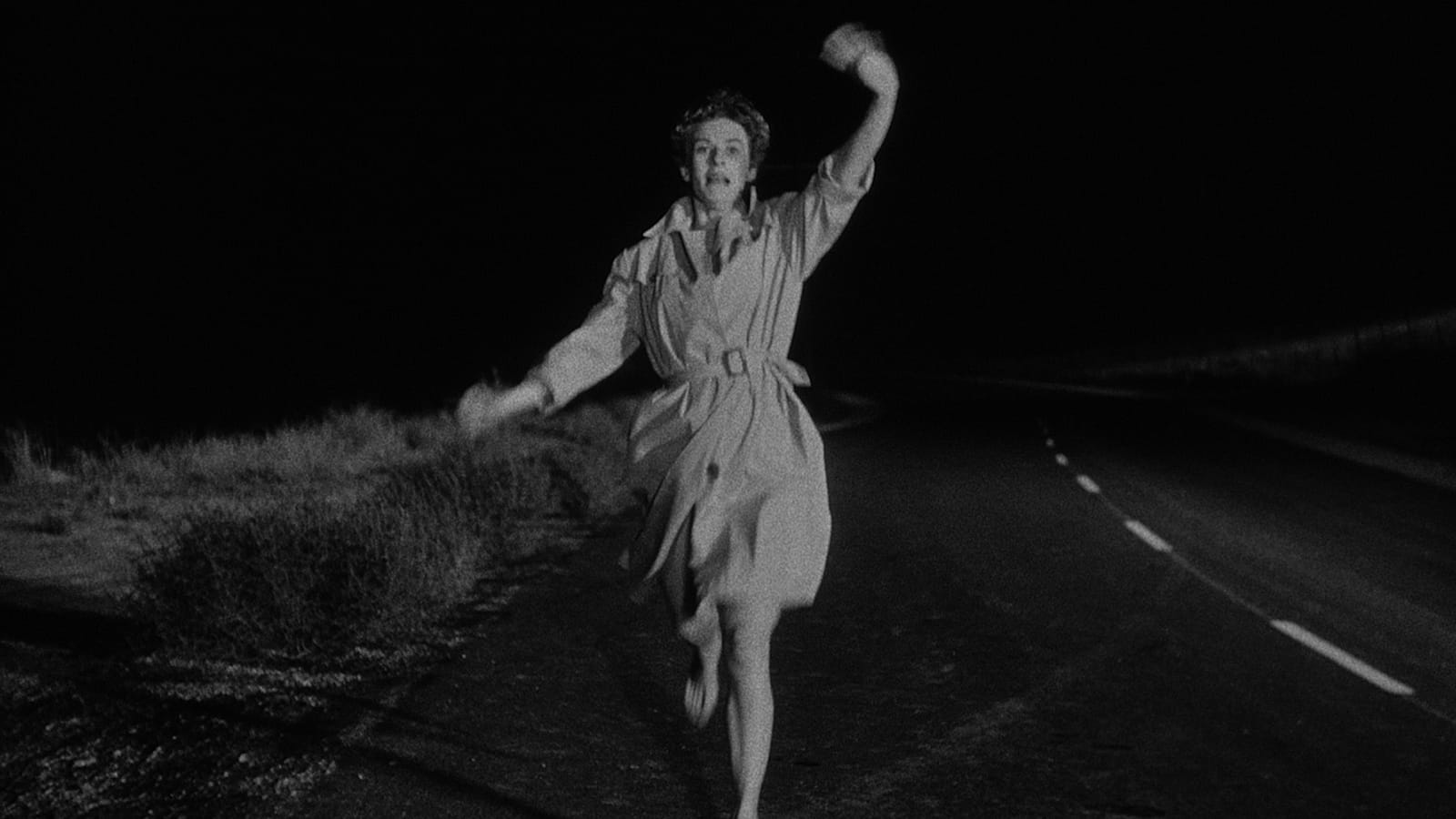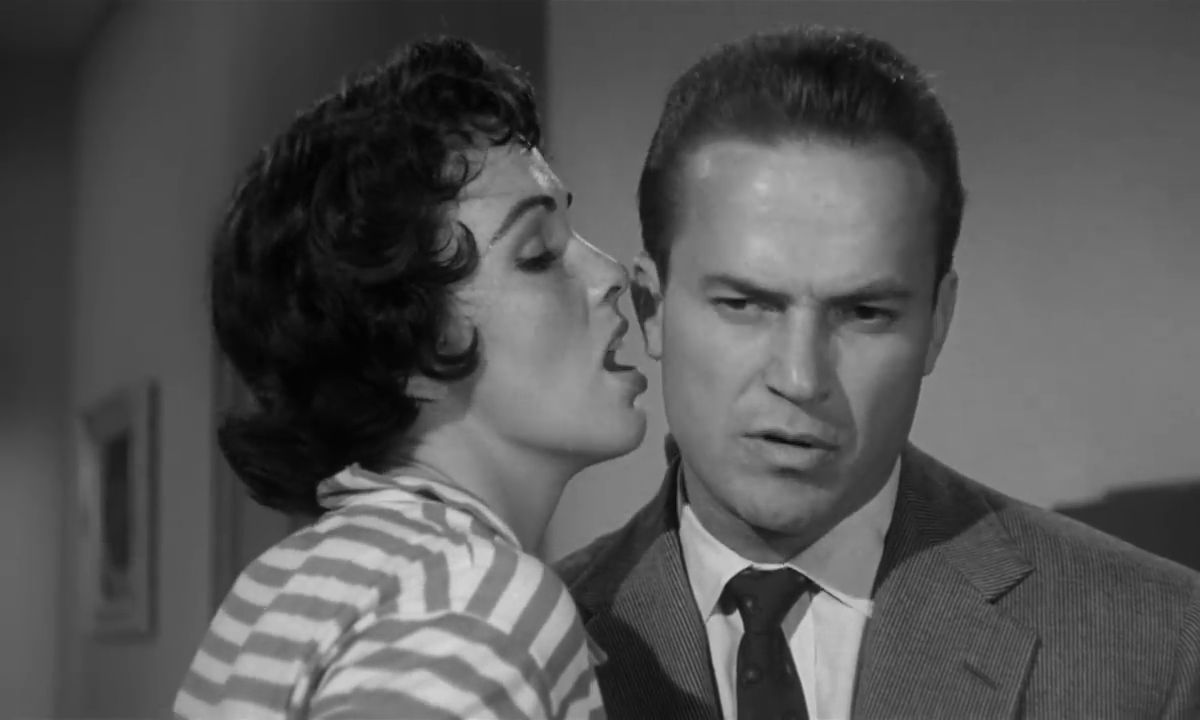In this absurd little film’s opening, a woman you may recognize as a young Cloris Leachman runs barefoot and naked onto an empty desert road in the dark of night. Our protagonist, detective Mike Hammer, happens to be the one driving down that stretch of road in a Jaguar sports car that is literally too small to fit him properly his head is in fact above the level of the windshield, and the rest of him fills the two-seater more tightly than he fills his own pants.

After running the Jaguar off the road, Mike Hammer takes one look at the naked, terrified woman and his face says it all: not another goddamned broad. He can hardly contain his anger as he begrudges her a ride. He offers his theory that she is a rape victim and is frankly annoyed that she couldn’t have just said “yes” and saved him the trouble of stopping. Cloris proceeds to moan and gasp less as though she is winded than she is fighting back a series of orgasms over the entire opening credits, which sprawl across the screen backward in motion and order as though composed by a dyslexic. Then it gets a little dark; within a matter of minutes, she’s tortured to death and Hammer is left for dead. In as little time, detective Mike Hammer finds himself lost in another labyrinthine plot. No attempt is made, fortunately, to convince us that this is all anything but silly.
Robert Aldrich’s Kiss Me Deadly may well be considered the ultimate entry in that classic movement of American film: film noir. I say “ultimate” not to imply that it is the best, for it is certainly not that. Rather, it is “ultimate” in that it can be viewed almost as a closing bookend and a final word on the movement itself. It’s no coincidence that the movement all but died shortly after the film’s release. Though, technically, Orson Welles probably gave noir its official, grand goodbye three years later with Touch of Evil, Kiss Me Deadly was nevertheless a harbinger of the end.
By the late fifties, noir was already becoming hard to take seriously; people were beginning to look at it as they do today, finding excitement and humor in conventions intended to convey the opposite. Kiss Me Deadly simply took film noir to an inevitable stopping point to such extremes and such absurdity that it left nowhere for the movement to go, and left it doomed to ridicule and parody and decades of tongue-in-cheek reenactments by everyone from Daffy Duck to Joseph Gordon-Levitt.
Certainly, one could not imagine taking the noir camera work, the skewed angles and deep shadows and high contrasts of black and white, much further than Aldrich does here; what began as film’s entry into German Expressionism has simply become another exploited convention. Nor could any film still operating under the firm grasp of the Hays Code be any sleazier, more violent, or more nihilistic; the film in fact stirred so much controversy for its sheer brutality that Aldrich had to wage a campaign to see it get even a limited release. It almost feels, at times, as though the film is actively trying to break something far beyond conventional boundaries, to actually break noir itself, and scorch the earth so nothing could ever come after it.
The plot is hardly coherent and seems to have little desire to follow any kind of logic. The performances of its cast of strictly B-level actors are laughable at best, but all for the better to deliver the nonsensical lines given to them. The clincher, of course, is the fact that the film is fully aware and fully in control of the spectacle it is making of itself. For all its violence and cynicism, the film remains delightfully playful with perhaps even a little contemptuous of its own material. Fitting then, that this should be the only true film noir based on a novel by Mickey Spillane.
If you’re not familiar with his work, Spillane’s series of Mike Hammer detective novels can best be described as terrible bullshit. Spillane didn’t so much write novels as mimic (badly) aspects of a genre devised by much better authors, all the while ratcheting up its most ludicrous elements to a cartoonish degree. He should have been writing comic books for juvenile American boys; somehow, he convinced himself his niche was prose. For what he lacked in writing talent at best, a terrible and shameless imitation of Chandler’s hard-boiled patter; he substituted sex and violence. The result sold itself to an audience with a developmental reading level of a horny adolescent but the self-perceived mature sophistication of an adult; in other words, every gum-chewing, baseball loving male of 1950s America.
With his outright, unapologetic hatred of all things feminine, intellectual, and especially Communist, Spillane was also praised as fine literature by the likes of Ayn Rand and the same crowd of angry white men that made her a bestseller. No surprise, then, that Spillane sold more copies than any author of his generation, and nobody was prouder of the fact than himself. It was Spillane who first turned Hammett and Chandler’s hard-boiled school of literature and its noir film counterpart into a big joke, all the while thinking he was playing it straight. But the victim Spillane merely raped and mutilated received a final, merciful coup de grace not by his hand, but by another. Its method of execution: adaptation.

A better writer, A.I. Bezzerides, was given the dubious honor of adapting Spillane’s shitty prose to the screen. No screenwriter has likely ever worn so mischievous a grin as he sat at his typewriter. His screenplay does not adapt its source material so much as subvert it and in the cheekiest of ways. In the novels, protagonist Mike Hammer is presented as perpetually angry, bigoted, misogynistic, and psychopathically violent-and all in the most positive sort of way; a vigilante and a sadist we are meant to cheer for, like some predecessor of Charles Bronson and rest of the 80s Action generation but with more and angrier opinions. He comes across to all but his author and fans as a dumb asshole. In his film adaptation, he is thus appropriately depicted as a dumb asshole.
This Mike Hammer is a sleazy opportunist? A private eye who specializes in divorce cases and blackmail (with himself as the blackmailer), whose drive through the indecipherable plot isn’t rage and a desire to murder some communists, but pure capitalism; a belief that somewhere at the bottom of all this stuff he doesn’t remotely understand is a big payoff. He’s still sadistically violent, and still dumb as a bag of his namesake…and somehow, now that his writer knows it, the qualities make him endearing in his own way. In the end, he’s so confused and helpless he has to be physically carried to a safe place outside of the plot by his own secretary. Mickey Spillane, of course, despised seeing his creation exposed and emasculated in this manner; he should have taken the hint and been thankful for it.
As a side note, I find myself unable to fathom the writer’s decision to include a character who has to be the most annoying sidekick in the history of film…a Greek auto mechanic who punctuates every ridiculous line by shouting “POW” or some absurd noise. I’m not sure if this is some kind of Greek stereotype or what; the black characters in the film act perfectly normal. It’s ironic that the only time Mike Hammer shows a hint of remorse is when this little oaf is crushed under a car. We, after all, are so sick of him by then that we’re thrilled to see him go. Hammer frets over the death longer than Sam Spade ever did for his partner. It becomes a sort of reversal, in which the audience plays the gleeful sadist and Hammer stares accusingly. Perhaps it’s just more of the screenwriter having fun with us.
The same mischief that got into the screenwriter’s depiction of Mike Hammer, after all, also turned the novel’s hackneyed plot and setting into its greatest feature. The setting is moved from Chicago to the place where all great noirs go to die, Los Angeles, and an L.A. we can scarcely recognize…and not only because most of its locations are confined to a vintage Bunker Hill that was stamped out under the feet of a series of skyscrapers not long after the film was shot. These events seem to take place in a twilight L.A., where the hard-boiled private eye lives in a posh, ultramodern apartment complete with a wall-mounted phone answering machine that looks like something out of the Jetsons; where femme fatales hide clues in recitations of Christina Rossetti poems, stool pigeons can be coerced into talking by threatening to smash their recordings of Caruso’s Pagliacci, villains whose names and motives are left to mystery only speak in riddles referring to the Old and New Testaments and to the Greek mythology which predated both, and the actual Greek seems to openly worship a first-generation Corvette.

What does any of it mean? Nothing and everything, for it soon becomes clear that this is the L.A. at the End of the Universe…that these things exist as scattered artifacts of a climaxed civilization that have all come to L.A., as many do, to finally be seared out of existence. How? Well, that becomes clear at the precise moment that Mike Hammer finds his Maltese Falcon, Macguffin, or “the Great Whatsit” as his secretary names it the greatest, perhaps, in movie history: a hinged lead box filled with nuclear fire and the apocalypse itself. The film at last reminds us that the real L.A….this place Chandler considered America’s Sodom and Gomorrah…is not Los Angeles but Los Alamos, and that the threat of our sharing those cities fate is in fact very real. That it seems to have no concept of how nuclear fission actually occurs only adds to the sheer mania of it all. Noir melds with Cold War paranoia and nuclear age science fiction in the most spectacular of ways. And this is why I can confidently call this the “ultimate” noir. Where else could the detective have gone from here?
Kiss Me Deadly stands as film noir’s furthest extreme before the absurdity of it all finally caught up with it, leaving little place to go outside of parody or post-modern revisitation. In the early nineties, modern day hack Frank Miller managed to out-Spillane Spillane with a series of comic books and Robert Rodriguez adapted them into 2005’s Sin City’a silly, ultraviolent cartoon, shameless in its desire to be nothing but a fun romp disguised as a genre once meant to convey misery and despair. Fifty years earlier, Kiss Me Deadly had already been there and done that…and did it all with a fantastically malicious intent.